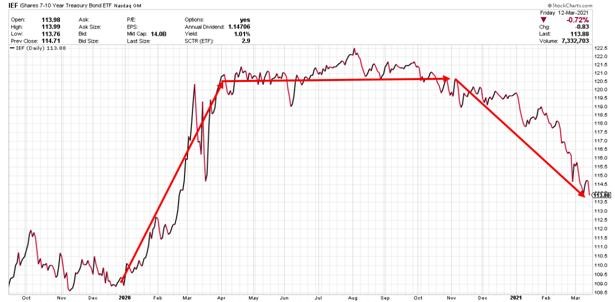CAMS Weekly View from the Corner – Week ending 3/12/21
March 15, 2021
“In terms of the stock market this may lead to a shift away from growth category companies and more toward value category companies as we see some evidence of this beginning.”
Weekly View “The Bond Market is Struggling” February 22, 2021
Dating back to seemingly creation or at least to stock market inception the discussion began as to the favored approach toward stock market style investing. That is to focus on growth stocks or to focus on value stocks.
Generally speaking the growth oriented approach is to focus on stocks of companies whose earnings are growing rapidly and are expected to grow even faster.
With current and expected growth these companies have much higher valuation levels awarded to them as market participants are willing to pay up for these companies with the expectation that extraordinary growth will reward them as the company brings these high expectations to fruition over time.
Value on the other hand are companies who have low valuation levels and in many cases seemingly have been forgotten by market participants as “old and boring going nowhere” companies relative to the fast paced if not exciting growth companies and their rapidly evolving story-lines.
The value type stock many times has a history of consistent revenues and earnings with relatively much slower growth rates with seemingly little prospects for growth rates to pick up notably. The above descriptions are meant as broad generalizations of each style approach.
Per our header excerpt we briefly shared in an edition a few weeks ago that evidence was building that the stock market was preparing to shift away from growth stocks and more towards value stocks. This has indeed entered the stock market landscape and has done so rapidly.
And Yes Back To The Bond Market
If you are a consistent reader of these Weekly Views you will recognize our seeming obsession with the bond market. This continues yet again because the bond market, as a central determinant of market based interest rates, plays a key role for all markets.
As bonds consistently drop in price their interest rate (yield) rises and in so doing leave a trail of consistently rising interest rates.
The aforementioned, highly valued growth stocks tend to struggle when interest rates are rising consistently and rapidly. With this you can see how the bond market can play out in the stock market relative to which is more in favor – growth or value.
The bond market struggle has certainly shown up in the growth-versus-value debate solidly in favor of value.


The two charts above offer a visual of our general narrative. Both charts are eighteen months in time and per the red lines both speak to the same general trends – up, sideways and then down.
The top chart is the Treasury bond market’s (7-10 year Maturities) price trend. The right side highlights the established downtrend.
The second chart is a ratio chart of growth stocks versus value stocks. When the line is rising it means growth stocks are outperforming value stocks. Conversely, when the line is trending down then value is outperforming growth.
Viewing the two together we can see that the established downtrend in the Treasury bond market has bled over to the relationship of growth-versus-value within the stock market with value clearly taking the upper hand. (Again, via the second chart, when the line is trending down this means value is outperforming growth.)
While stock market participants have quickly shifted to value the real high flying growth stocks (a.k.a. fantasy stocks) have in many cases taken on serious downside pricing. We distinguish the “real high flyers” as companies who typically do not have any real growth rates in earnings yet because they typically do not have earnings yet. (True story)
These companies are those flying high on speculative fever many times based on hope that they will one day own their industries to the likes of Microsoft, Amazon and Google. Ultra low interest rates with loads of printed money from the FED floating around create a perfect backdrop for such speculative fever to occur.
Consistently rising interest rates, via the bond market, is the nemesis for such a fever and hence fantasies to come down to reality. As value has come front-and-center within the stock market these high flying stocks have been notably reduced in price.
If the above stated and visual trends continue we would expect more downside for the high flying growth stocks in particular as speculative fever is reduced.
Outside of that it appears a time-frame of value stocks outperforming growth stocks has begun.
I wish you well…
Ken Reinhart
Director, Market Research & Portfolio Analysis
Footnote:
H&UP’s is a quick summation of a rating system for SPX9 (abbreviation encompassing 9 Sectors of the S&P 500 with 107 sub-groups within those 9 sectors) that quickly references the percentage that is deemed healthy and higher (H&UP). This comes from the proprietary “V-NN” ranking system that is composed of 4 ratings which are “V-H-N-or NN”. A “V” or an “H” is a positive or constructive rank for said sector or sub-group within the sectors.
This commentary is presented only to provide perspectives on investment strategies and opportunities. The material contains opinions of the author, which are subject to markets change without notice. Statements concerning financial market trends are based on current market conditions which fluctuate. References to specific securities and issuers are for descriptive purposes only and are not intended to be, and should not be interpreted as, recommendations to purchase or sell such securities. There is no guarantee that any investment strategy will work under all market conditions. Each investor should evaluate their ability to invest for the long-term, especially during periods of downturn in the market. PERFORMANCE IS NOT GUARANTEED AND LOSSES CAN OCCUR WITH ANY INVESTMENT STRATEGY.